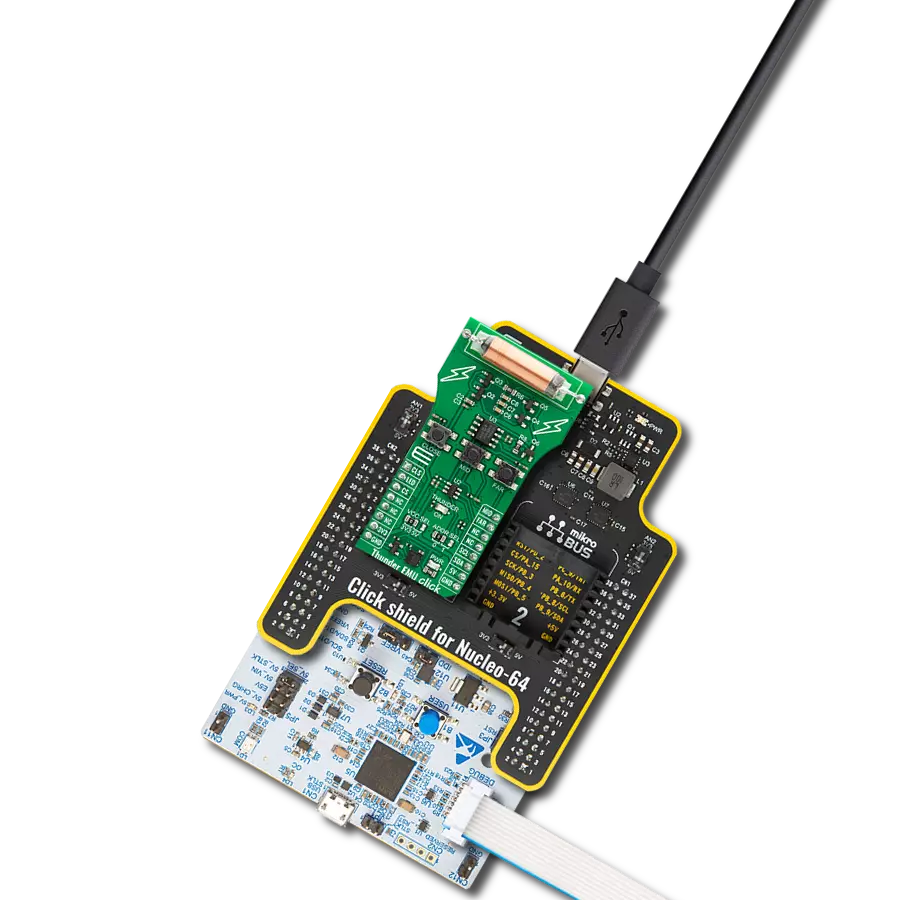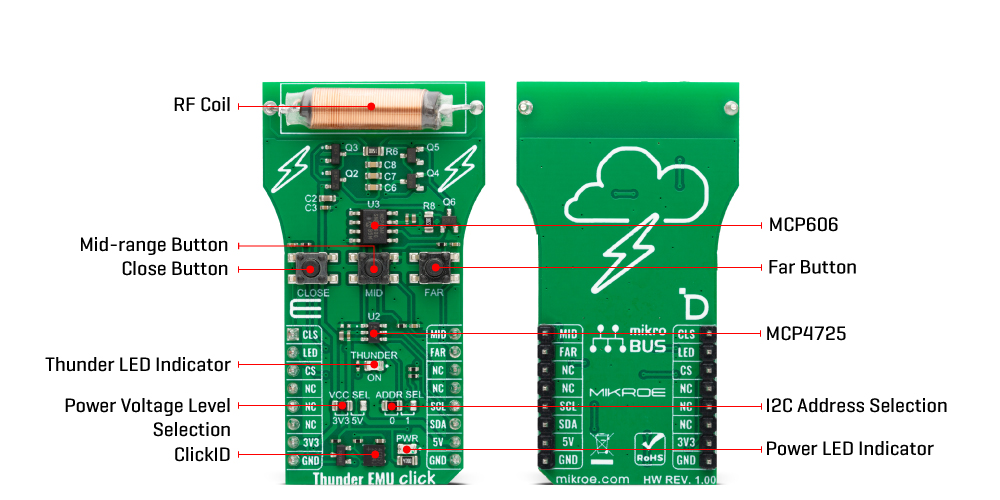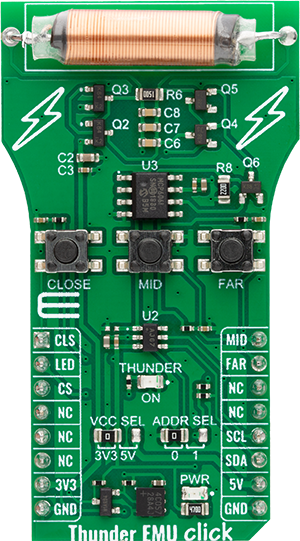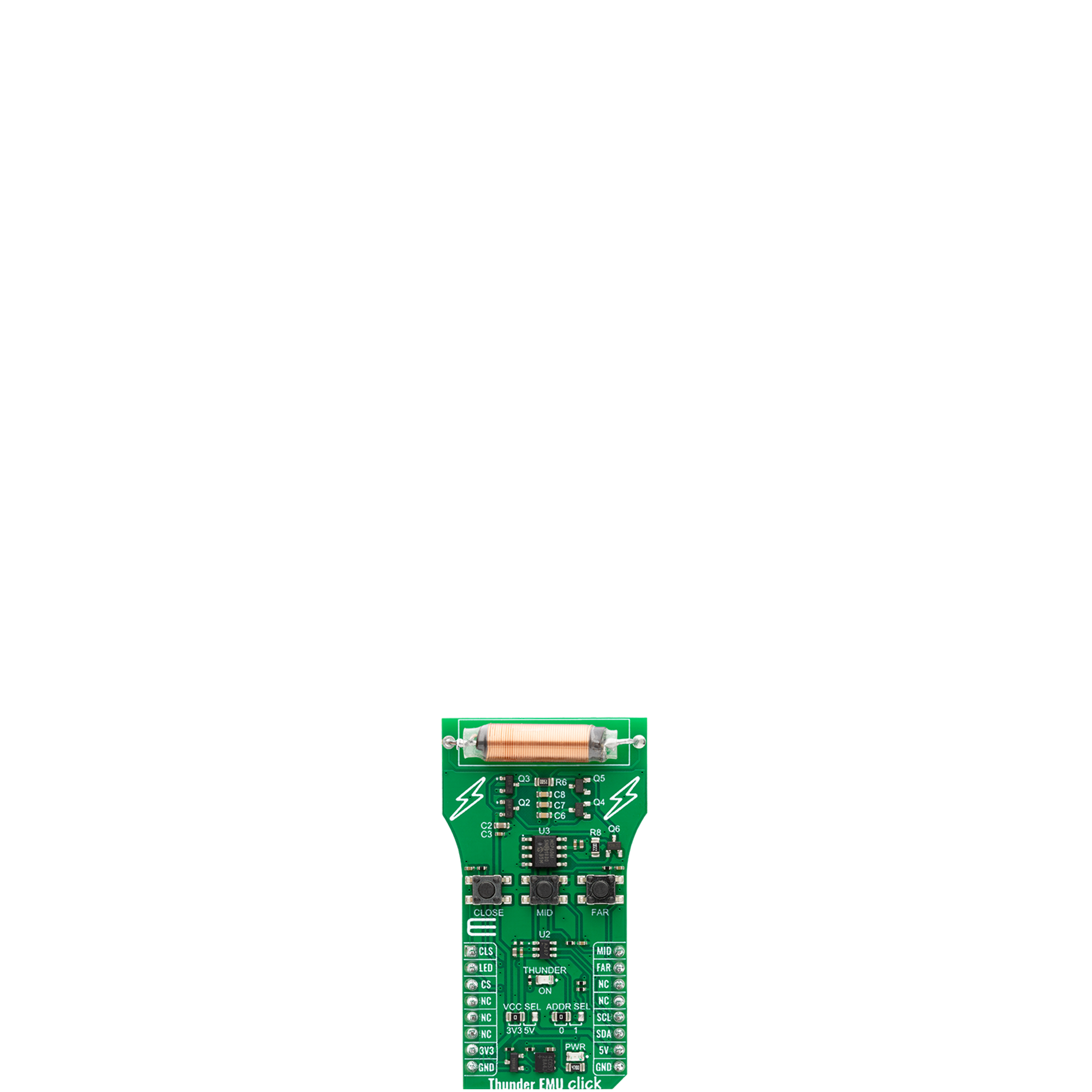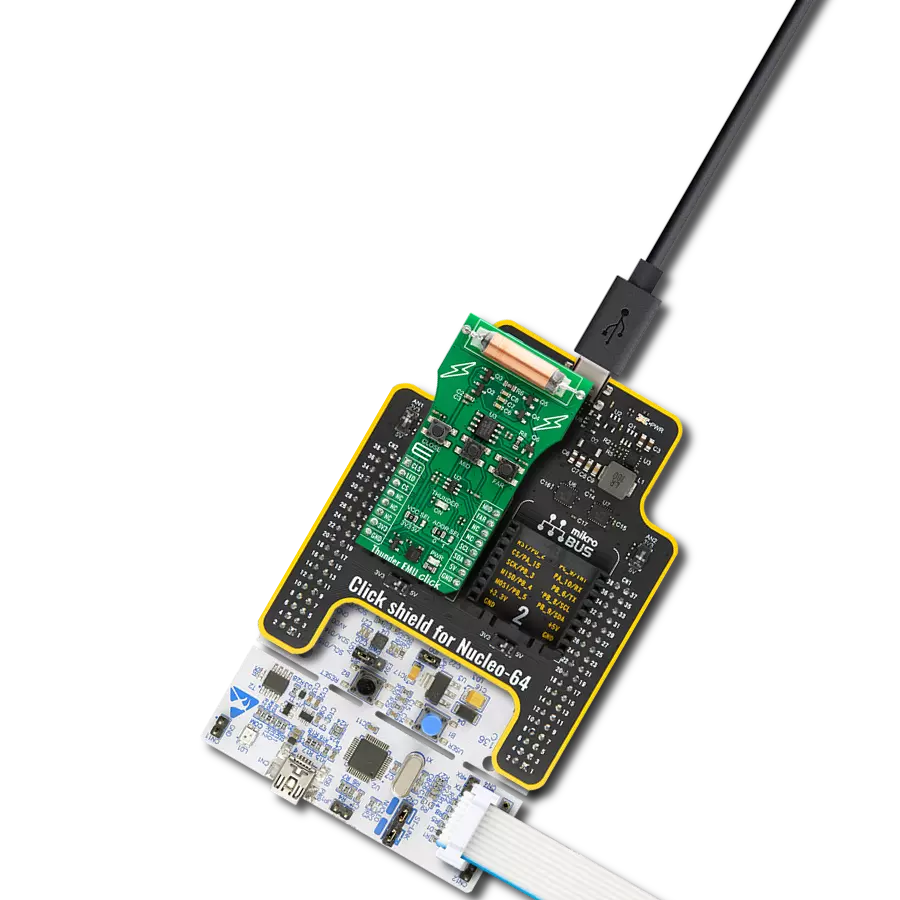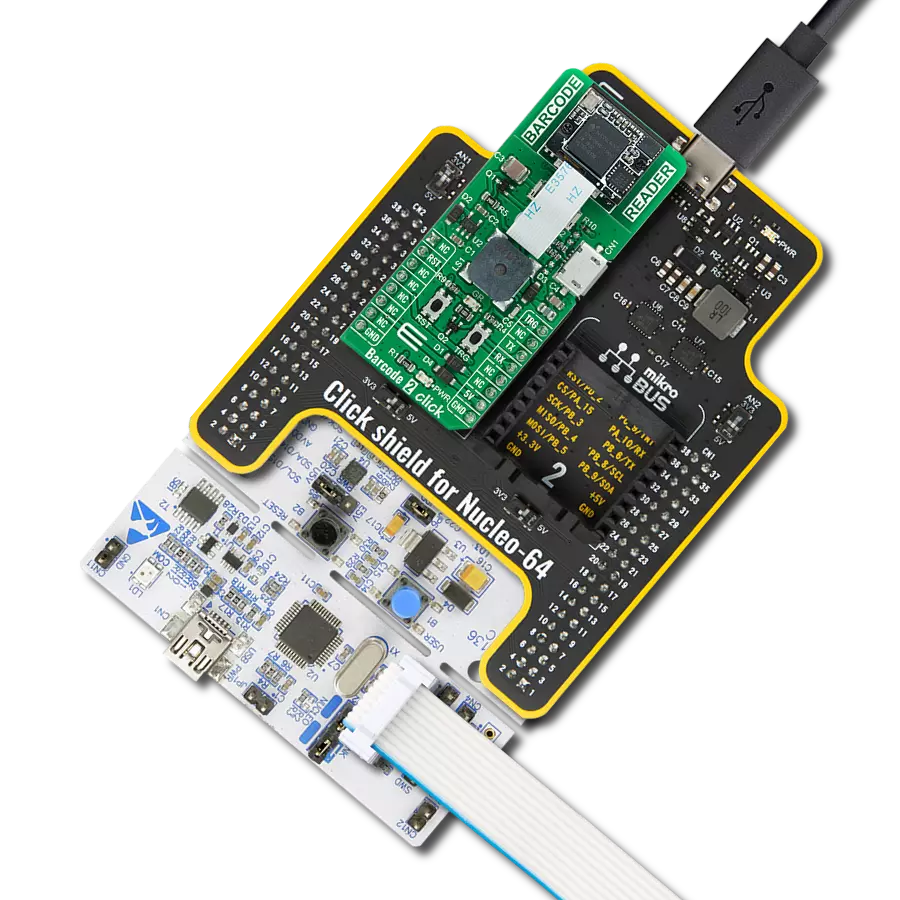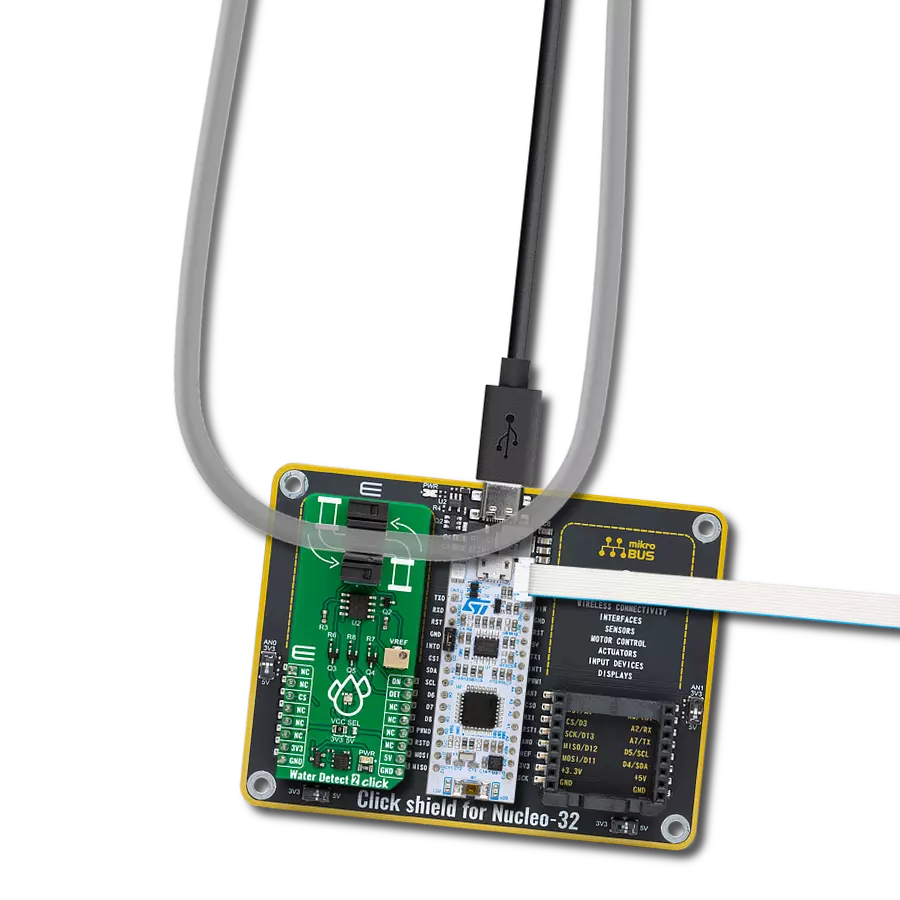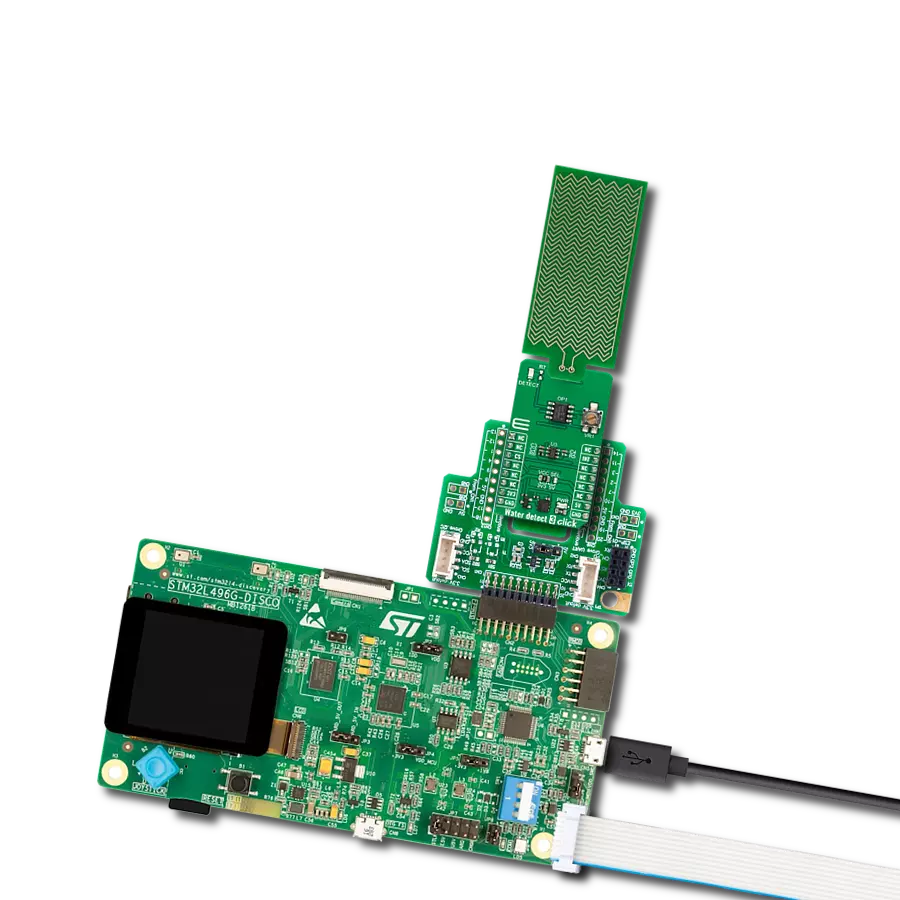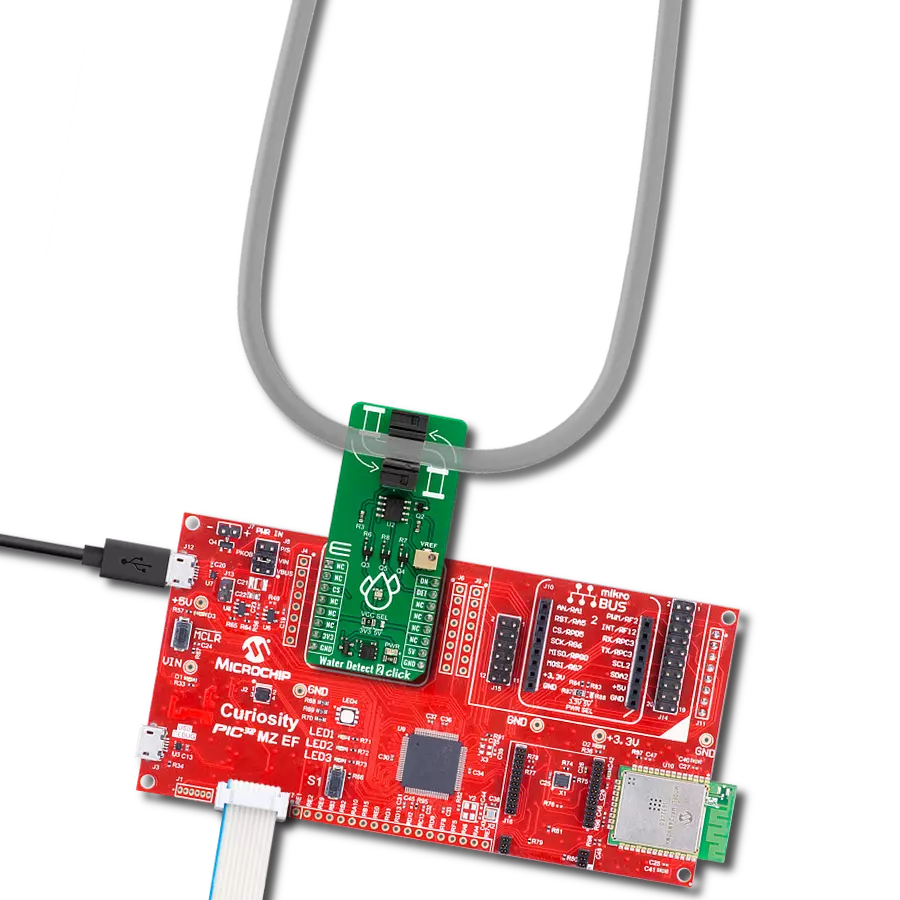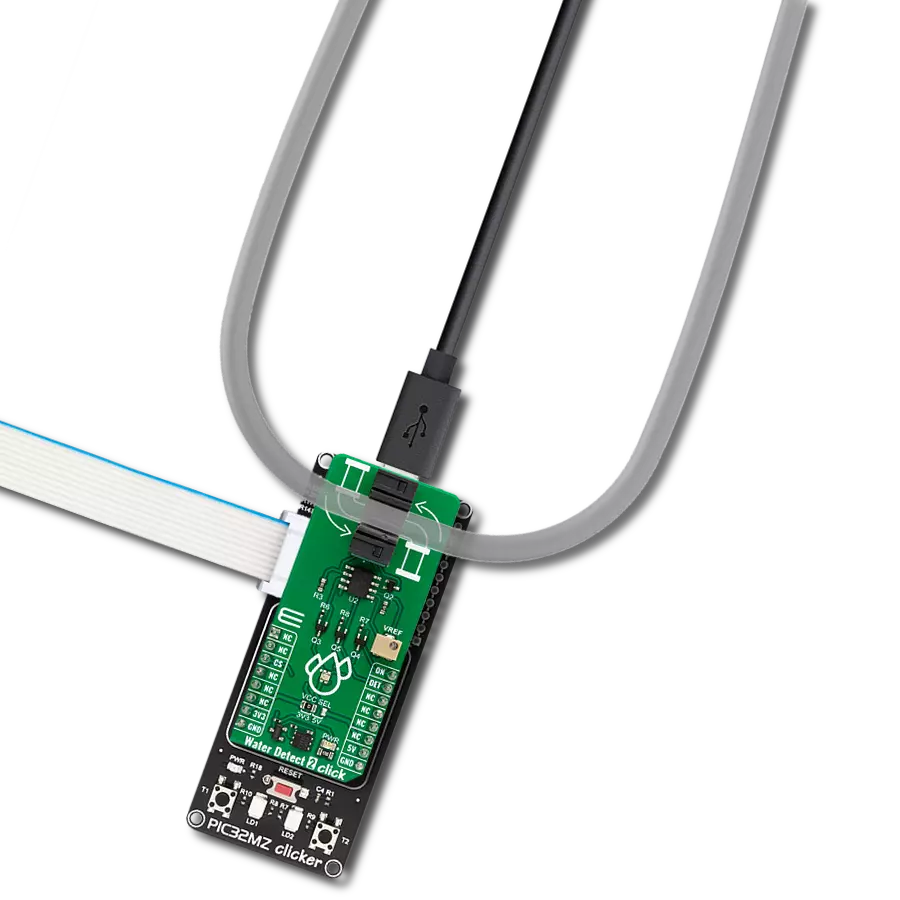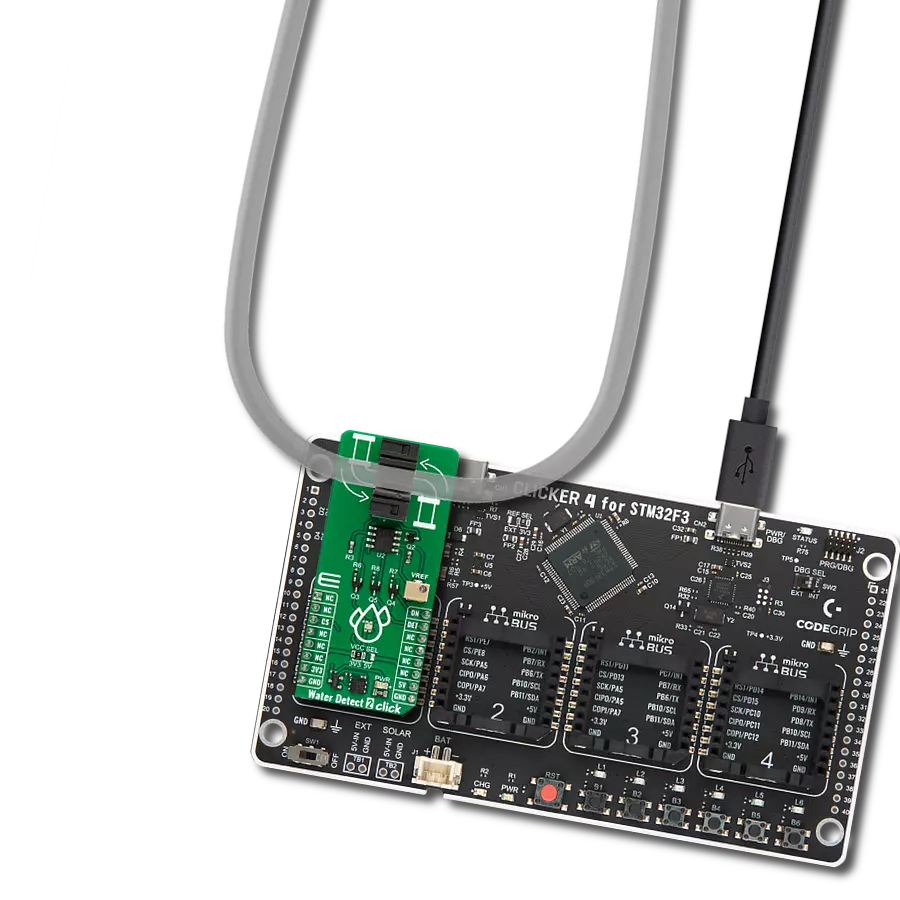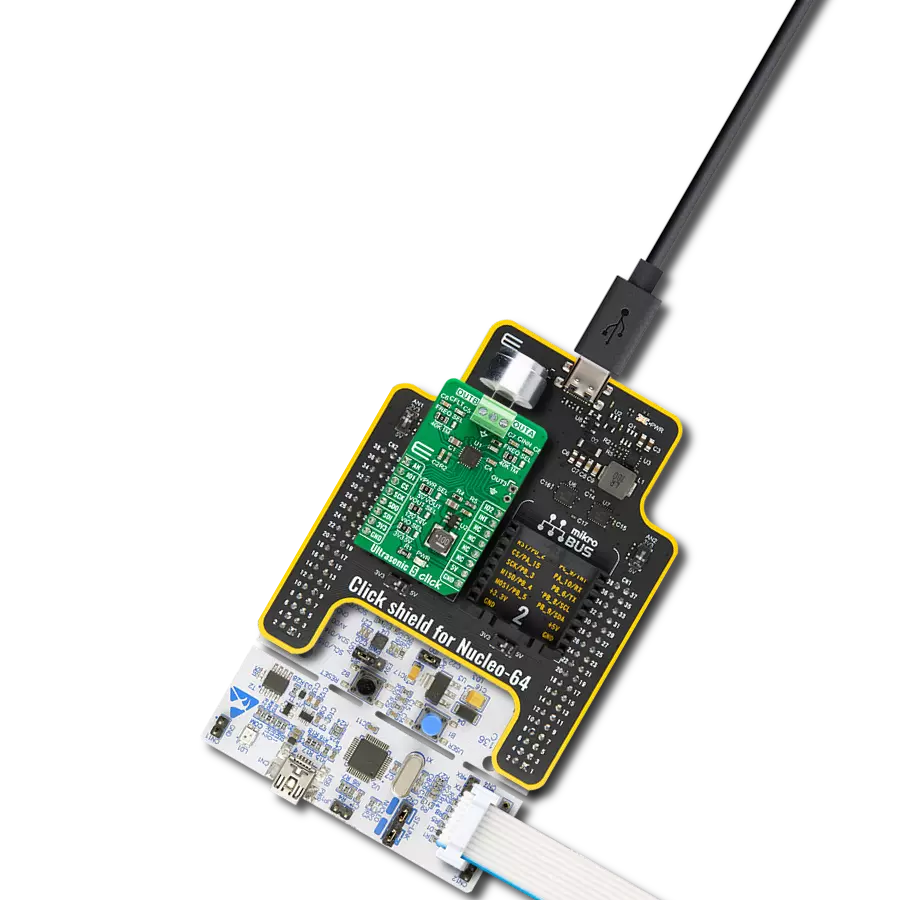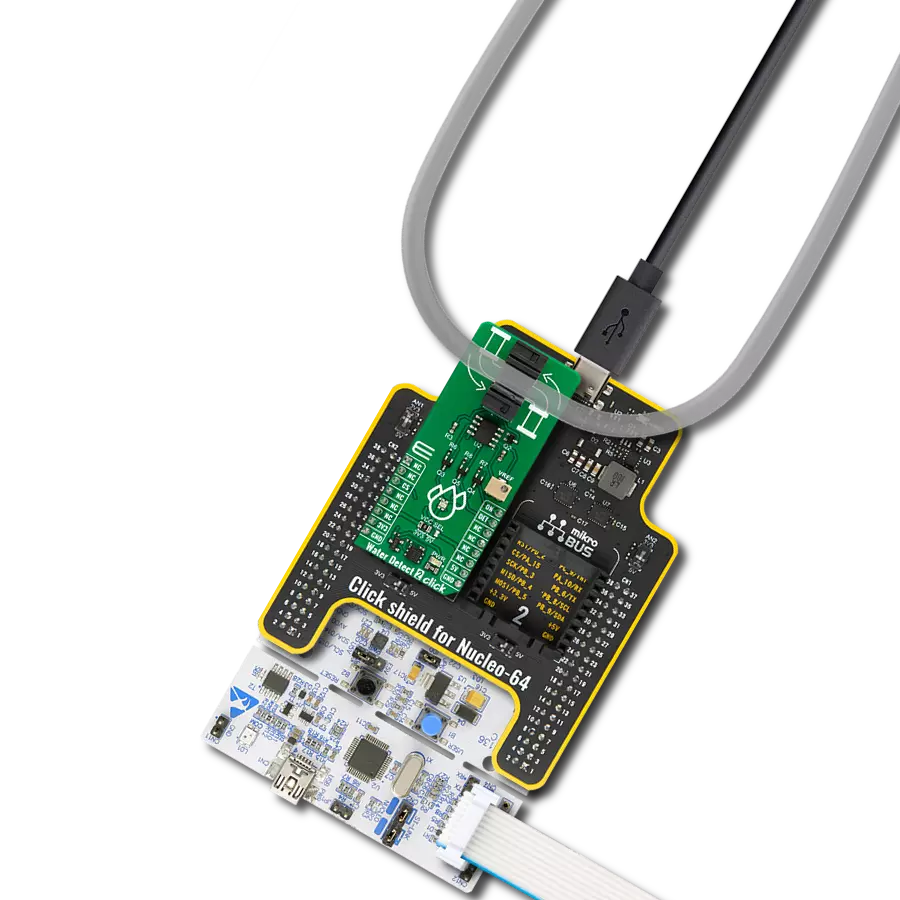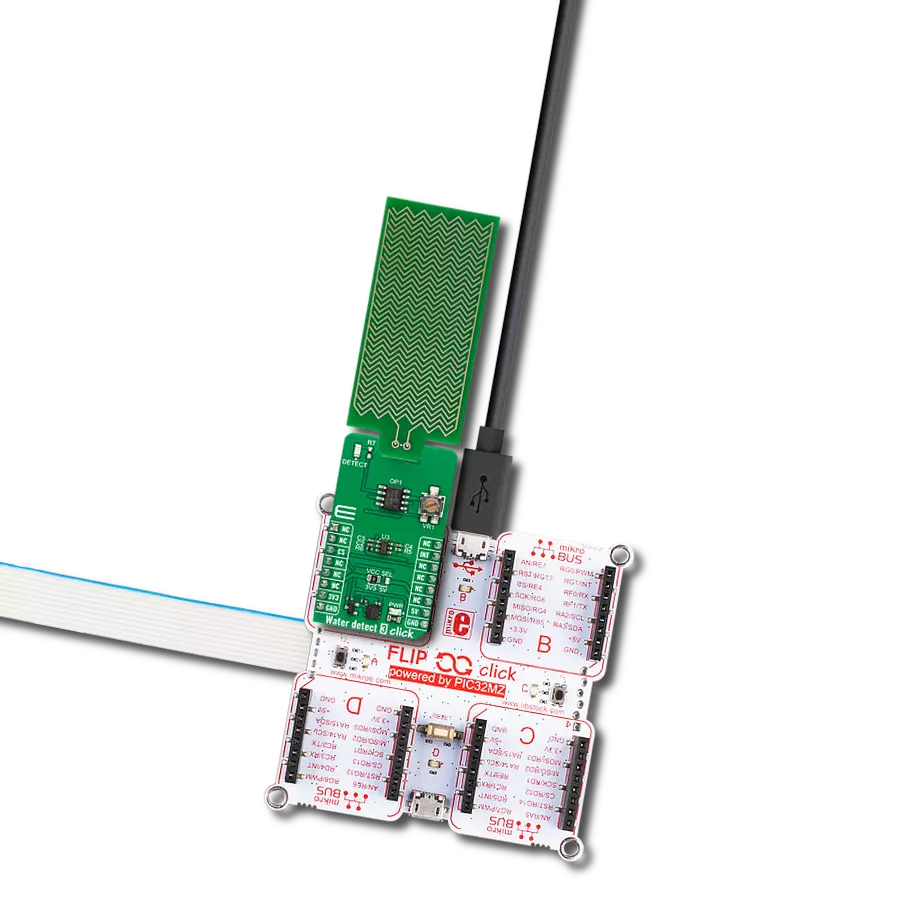Gain a reliable way to emulate lightning strikes and test detector responses across various simulated distances
A
A
Hardware Overview
How does it work?
Thunder EMU Click is based on the circuits generating an RF signal miming lightning strikes. The onboard MCP4725 is a 12-bit DAC from Microchip, and it is a precision output amplifier that allows you to achieve rail-to-rail analog output swing. The input and output data can be stored in the EEPROM of the DAC, which in turn enables you to hold the data during power-off time. This analog output of the DAC is then amplified over the MCP606, a CMOS operational amplifier from Microchip. The MCP606 is unity-gain stable with low offset voltage. It also includes rail-to-rail output swing capability. The analog output is then forwarded to the coil of an inductor. The coil of an inductor mimics a lightning signal on a smaller range than the real lightning will usually do. Of
course, the Thunder EMU Click is intended for testing and debugging purposes. No matter what, you can still mimic the different distances of the coming storm lightning. There are three buttons onboard labeled CLOSE, MID, and FAR, which represent mimicking close, mid-range, and far lightning. By combining FAR and MID pressed buttons together, you can select slow-timed lightning strike mode (every 5 minutes), MID and CLOSE together for fast-time lightning stroke mode (every 15 seconds), and all three together for random times lightning strike (from 30 seconds to 30 minutes). The actual „thunder“ of this Click board™ can be „visible“ over the red THUNDER ON LED. Thunder EMU Click uses a standard 2-Wire I2C interface of the MCO4725 to communicate
with the host MCU, supporting standard, fast, and high speeds up to 3.4Mbps. The I2C address can be selected over the ADDR SEL jumper. Pins CLS, MID, and FAR are connected to onboard buttons and have input functions. The LED is an output pin for the THUNDER ON LED. This Click board™ can operate with either 3.3V or 5V logic voltage levels selected via the VCC SEL jumper. This way, both 3.3V and 5V capable MCUs can use the communication lines properly. Also, this Click board™ comes equipped with a library containing easy-to-use functions and an example code that can be used as a reference for further development.
Features overview
Development board
Nucleo-64 with STM32G474R MCU offers a cost-effective and adaptable platform for developers to explore new ideas and prototype their designs. This board harnesses the versatility of the STM32 microcontroller, enabling users to select the optimal balance of performance and power consumption for their projects. It accommodates the STM32 microcontroller in the LQFP64 package and includes essential components such as a user LED, which doubles as an ARDUINO® signal, alongside user and reset push-buttons, and a 32.768kHz crystal oscillator for precise timing operations. Designed with expansion and flexibility in mind, the Nucleo-64 board features an ARDUINO® Uno V3 expansion connector and ST morpho extension pin
headers, granting complete access to the STM32's I/Os for comprehensive project integration. Power supply options are adaptable, supporting ST-LINK USB VBUS or external power sources, ensuring adaptability in various development environments. The board also has an on-board ST-LINK debugger/programmer with USB re-enumeration capability, simplifying the programming and debugging process. Moreover, the board is designed to simplify advanced development with its external SMPS for efficient Vcore logic supply, support for USB Device full speed or USB SNK/UFP full speed, and built-in cryptographic features, enhancing both the power efficiency and security of projects. Additional connectivity is
provided through dedicated connectors for external SMPS experimentation, a USB connector for the ST-LINK, and a MIPI® debug connector, expanding the possibilities for hardware interfacing and experimentation. Developers will find extensive support through comprehensive free software libraries and examples, courtesy of the STM32Cube MCU Package. This, combined with compatibility with a wide array of Integrated Development Environments (IDEs), including IAR Embedded Workbench®, MDK-ARM, and STM32CubeIDE, ensures a smooth and efficient development experience, allowing users to fully leverage the capabilities of the Nucleo-64 board in their projects.
Microcontroller Overview
MCU Card / MCU
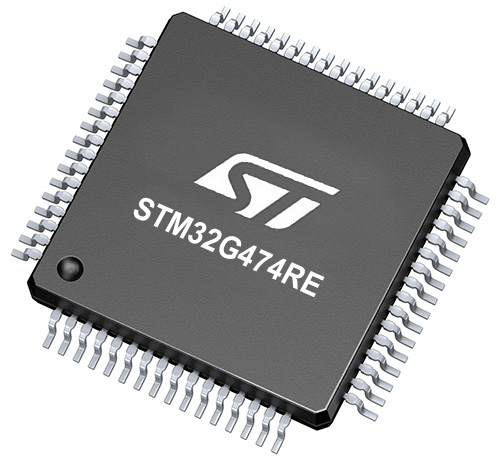
Architecture
ARM Cortex-M4
MCU Memory (KB)
512
Silicon Vendor
STMicroelectronics
Pin count
64
RAM (Bytes)
128k
You complete me!
Accessories
Click Shield for Nucleo-64 comes equipped with two proprietary mikroBUS™ sockets, allowing all the Click board™ devices to be interfaced with the STM32 Nucleo-64 board with no effort. This way, Mikroe allows its users to add any functionality from our ever-growing range of Click boards™, such as WiFi, GSM, GPS, Bluetooth, ZigBee, environmental sensors, LEDs, speech recognition, motor control, movement sensors, and many more. More than 1537 Click boards™, which can be stacked and integrated, are at your disposal. The STM32 Nucleo-64 boards are based on the microcontrollers in 64-pin packages, a 32-bit MCU with an ARM Cortex M4 processor operating at 84MHz, 512Kb Flash, and 96KB SRAM, divided into two regions where the top section represents the ST-Link/V2 debugger and programmer while the bottom section of the board is an actual development board. These boards are controlled and powered conveniently through a USB connection to program and efficiently debug the Nucleo-64 board out of the box, with an additional USB cable connected to the USB mini port on the board. Most of the STM32 microcontroller pins are brought to the IO pins on the left and right edge of the board, which are then connected to two existing mikroBUS™ sockets. This Click Shield also has several switches that perform functions such as selecting the logic levels of analog signals on mikroBUS™ sockets and selecting logic voltage levels of the mikroBUS™ sockets themselves. Besides, the user is offered the possibility of using any Click board™ with the help of existing bidirectional level-shifting voltage translators, regardless of whether the Click board™ operates at a 3.3V or 5V logic voltage level. Once you connect the STM32 Nucleo-64 board with our Click Shield for Nucleo-64, you can access hundreds of Click boards™, working with 3.3V or 5V logic voltage levels.
Used MCU Pins
mikroBUS™ mapper
Take a closer look
Click board™ Schematic
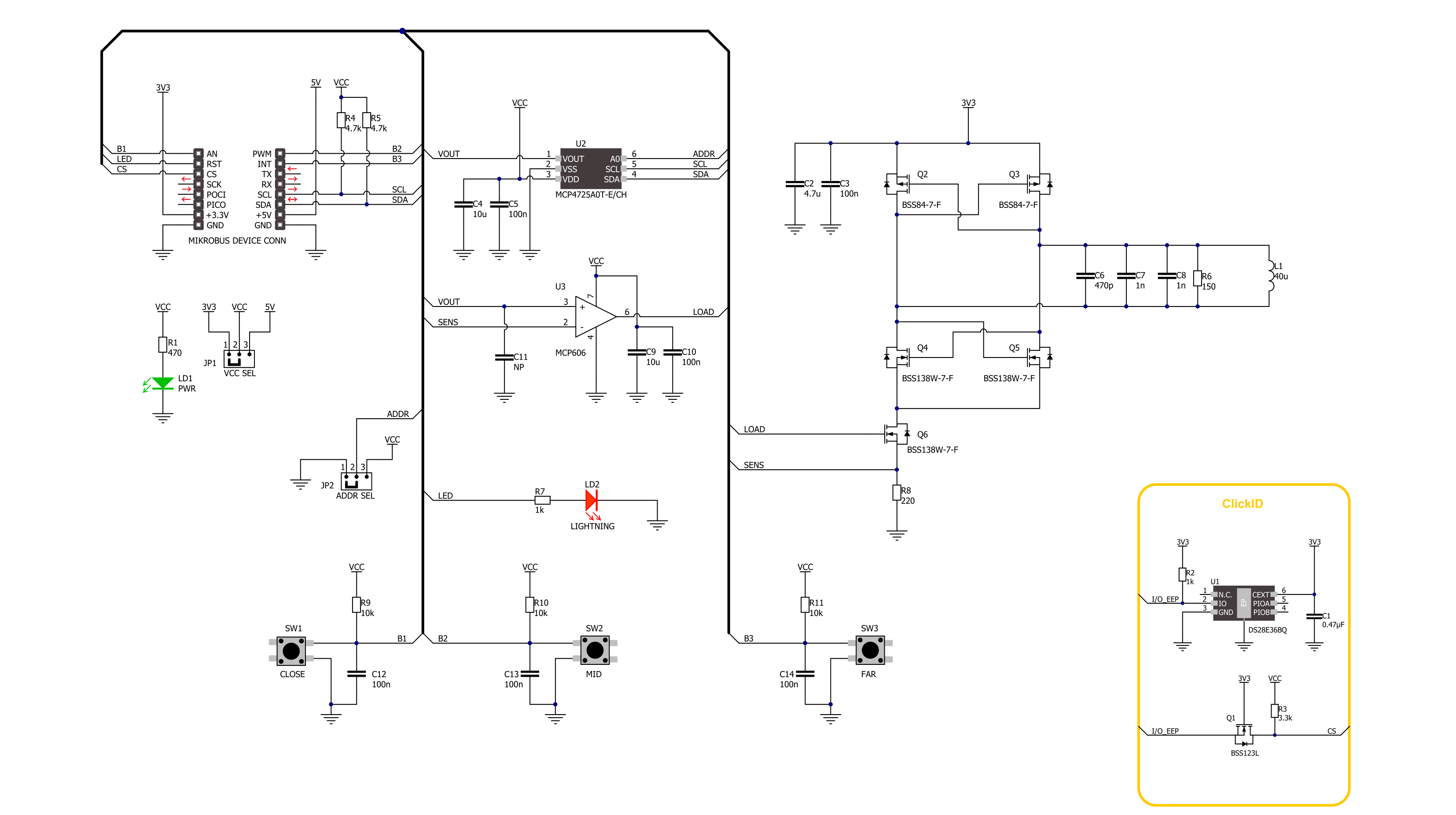
Step by step
Project assembly
Track your results in real time
Application Output
1. Application Output - In Debug mode, the 'Application Output' window enables real-time data monitoring, offering direct insight into execution results. Ensure proper data display by configuring the environment correctly using the provided tutorial.

2. UART Terminal - Use the UART Terminal to monitor data transmission via a USB to UART converter, allowing direct communication between the Click board™ and your development system. Configure the baud rate and other serial settings according to your project's requirements to ensure proper functionality. For step-by-step setup instructions, refer to the provided tutorial.

3. Plot Output - The Plot feature offers a powerful way to visualize real-time sensor data, enabling trend analysis, debugging, and comparison of multiple data points. To set it up correctly, follow the provided tutorial, which includes a step-by-step example of using the Plot feature to display Click board™ readings. To use the Plot feature in your code, use the function: plot(*insert_graph_name*, variable_name);. This is a general format, and it is up to the user to replace 'insert_graph_name' with the actual graph name and 'variable_name' with the parameter to be displayed.

Software Support
Library Description
Thunder EMU Click demo application is developed using the NECTO Studio, ensuring compatibility with mikroSDK's open-source libraries and tools. Designed for plug-and-play implementation and testing, the demo is fully compatible with all development, starter, and mikromedia boards featuring a mikroBUS™ socket.
Example Description
This example demonstrates the use of Thunder EMU Click board by generating CLOSE, MID, or FAR range thunder signal depending on the Click push-buttons state.
Key functions:
thunderemu_cfg_setup- Config Object Initialization function.thunderemu_init- Initialization function.thunderemu_default_cfg- Click Default Configuration function.thunderemu_generate_thunder- This function generates close, mid or far range thunder signal by setting the predefined DAC output profile at the specific timing.thunderemu_get_close_pin- This function returns the CLOSE pin logic state.thunderemu_get_mid_pin- This function returns the MID pin logic state.
Application Init
Initializes the driver and performs the Click default configuration.
Application Task
Checks if any of the Click board buttons are pressed and then generates a thunder signal related to the pressed button and displays an appropriate message on the USB UART.
Open Source
Code example
The complete application code and a ready-to-use project are available through the NECTO Studio Package Manager for direct installation in the NECTO Studio. The application code can also be found on the MIKROE GitHub account.
/*!
* @file main.c
* @brief Thunder EMU Click example
*
* # Description
* This example demonstrates the use of Thunder EMU Click board by generating
* CLOSE, MID, or FAR range thunder signal depending on the Click push-buttons state.
*
* The demo application is composed of two sections :
*
* ## Application Init
* Initializes the driver and performs the Click default configuration.
*
* ## Application Task
* Checks if any of the Click board buttons are pressed and then generates a thunder
* signal related to the pressed button and displays an appropriate message on the USB UART.
*
* @note
* Thunder EMU Click should be used in combination with a Thunder Click which detects
* a lightning presence. The emulator is calibrated for ranges of up to 15cm from the sensor board.
* It's recommended to distant both Click boards from their development boards using a Shuttle Click
* to reduce the board noise that can affect the sensor and emulator performance.
*
* @author Stefan Filipovic
*
*/
#include "board.h"
#include "log.h"
#include "thunderemu.h"
static thunderemu_t thunderemu;
static log_t logger;
void application_init ( void )
{
log_cfg_t log_cfg; /**< Logger config object. */
thunderemu_cfg_t thunderemu_cfg; /**< Click config object. */
/**
* Logger initialization.
* Default baud rate: 115200
* Default log level: LOG_LEVEL_DEBUG
* @note If USB_UART_RX and USB_UART_TX
* are defined as HAL_PIN_NC, you will
* need to define them manually for log to work.
* See @b LOG_MAP_USB_UART macro definition for detailed explanation.
*/
LOG_MAP_USB_UART( log_cfg );
log_init( &logger, &log_cfg );
log_info( &logger, " Application Init " );
// Click initialization.
thunderemu_cfg_setup( &thunderemu_cfg );
THUNDEREMU_MAP_MIKROBUS( thunderemu_cfg, MIKROBUS_1 );
if ( I2C_MASTER_ERROR == thunderemu_init( &thunderemu, &thunderemu_cfg ) )
{
log_error( &logger, " Communication init." );
for ( ; ; );
}
if ( THUNDEREMU_ERROR == thunderemu_default_cfg ( &thunderemu ) )
{
log_error( &logger, " Default configuration." );
for ( ; ; );
}
log_info( &logger, " Application Task " );
}
void application_task ( void )
{
if ( !thunderemu_get_close_pin ( &thunderemu ) )
{
if ( THUNDEREMU_OK == thunderemu_generate_thunder ( &thunderemu, THUNDEREMU_MODE_CLOSE ) )
{
log_printf( &logger, " Close range thunder signal generated!\r\n\n" );
Delay_ms ( 500 );
}
}
else if ( !thunderemu_get_mid_pin ( &thunderemu ) )
{
if ( THUNDEREMU_OK == thunderemu_generate_thunder ( &thunderemu, THUNDEREMU_MODE_MID ) )
{
log_printf( &logger, " Mid range thunder signal generated!\r\n\n" );
Delay_ms ( 500 );
}
}
else if ( !thunderemu_get_far_pin ( &thunderemu ) )
{
if ( THUNDEREMU_OK == thunderemu_generate_thunder ( &thunderemu, THUNDEREMU_MODE_FAR ) )
{
log_printf( &logger, " Far range thunder signal generated!\r\n\n" );
Delay_ms ( 500 );
}
}
}
int main ( void )
{
/* Do not remove this line or clock might not be set correctly. */
#ifdef PREINIT_SUPPORTED
preinit();
#endif
application_init( );
for ( ; ; )
{
application_task( );
}
return 0;
}
// ------------------------------------------------------------------------ END
Additional Support
Resources
Category:Miscellaneous
